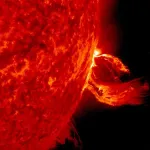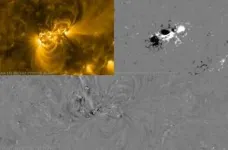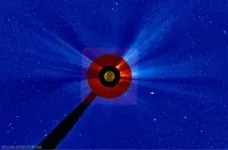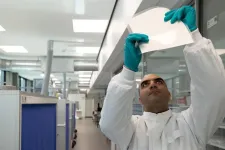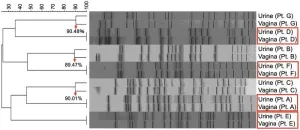(Press-News.org) New dawn for space storm alerts could help shield Earth's tech
Royal Astronomical Society press release
RAS PR 24/22 (NAM 8)
For immediate release
Space storms could soon be forecasted with greater accuracy than ever before thanks to a big leap forward in our understanding of exactly when a violent solar eruption may hit Earth.
Scientists say it is now possible to predict the precise speed a coronal mass ejection (CME) is travelling at and when it will smash into our planet – even before it has fully erupted from the Sun.
CMEs are bursts of gas and magnetic fields spewed into space from the solar atmosphere.
They can cause geomagnetic storms that have the potential to wreak havoc with terrestrial technology in Earth's orbit and on its surface, which is why experts across the globe are striving to improve space weather forecasts.
Advancements such as this one could make a huge difference in helping to protect infrastructure that is vital to our everyday lives, according to researchers at Aberystwyth University, who will present their findings today at the Royal Astronomical Society's National Astronomy Meeting in Hull.
They made their discovery after studying specific areas on the Sun called 'Active Regions', which have strong magnetic fields where CMEs are born. The researchers monitored how these areas changed in the periods before, during and after an eruption.
A vital aspect which they looked at was the "critical height" of the Active Regions, which is the height at which the magnetic field becomes unstable and can lead to a CME.
"By measuring how the strength of the magnetic field decreases with height, we can determine this critical height," said lead researcher Harshita Gandhi, a solar physicist at Aberystwyth University.
"This data can then be used along with a geometric model which is used to track the true speed of CMEs in three dimensions, rather than just two, which is essential for precise predictions."
She added: "Our findings reveal a strong relationship between the critical height at CME onset and the true CME speed.
"This insight allows us to predict the CME's speed and, consequently, its arrival time on Earth, even before the CME has fully erupted."
When these CMEs hit the Earth they can trigger a geomagnetic storm which is capable of producing stunning aurorae, often referred to in the northern hemisphere as the Northern Lights.
But the storms also have the potential to disrupt vital systems we rely on daily, including satellites, power grids, and communication networks, which is why scientists worldwide are working hard to improve our ability to better predict when CMEs will hit Earth.
This requires knowing a more accurate speed of the CME shortly after it erupts from the Sun to better provide advance warnings of when it will reach our planet.
Accurate speed predictions enable better estimates of when a CME will reach Earth, providing crucial advance warnings.
"Understanding and using the critical height in our forecasts improves our ability to warn about incoming CMEs, helping to protect the technology that our modern lives depend on," Gandhi said.
"Our research not only enhances our understanding of the Sun's explosive behaviour but also significantly improves our ability to forecast space weather events.
"This means better preparation and protection for the technological systems we rely on every day."
Media contacts
Sam Tonkin
Royal Astronomical Society
Mob: +44 (0)7802 877 700
press@ras.ac.uk
Dr Robert Massey
Royal Astronomical Society
Mob: +44 (0)7802 877 699
press@ras.ac.uk
Megan Eaves
Royal Astronomical Society
press@ras.ac.uk
Science contacts
Harshita Gandhi
Aberystwyth University
hag43@aber.ac.uk
Images and captions
CME stock image
Caption: A coronal mass ejection is seen erupted from the Sun in June 2015.
Credit: NASA Goddard Space Flight Center
Active Region eruption
Caption: This clip shows the before, during and post eruption state of the Active Region AR11158, with the top left panel showing the AR in 171 wavelength, the top right panel a cutout of HMI magnetogram and the bottom panel a running difference movie.
Credit: Jhelioviewer
CME headed for Earth
Caption: This clip shows a coronal mass ejection which erupted from AR11158 on its way to Earth, moving outwards in LASCO c2 and c3 field of view.
Credit: Jhelioviewer
CME stages
Caption: The different stages of a coronal mass ejection, from onset (left), to post-eruption (middle) and travel towards objects like Earth in our solar system (right).
Credit: Temmer et al. 2021
Magnetic field
Caption: Magnetic field lines at different heights above the photosphere extrapolated using Greens function approach as seen from top to bottom.
Credit: Harshita Gandhi
Critical height
Caption: Left - shows a PIL averaged decay index profile versus height above the photosphere in Mm at the time of CME eruption with critical height as 61.47 Mm. Right - shows critical height over time for AR11158 with red and black dotted lines indicating CME onset and C2 time.
Credit: Harshita Gandhi
Notes for editors
The NAM 2024 conference is principally sponsored by the Royal Astronomical Society, the Science and Technology Facilities Council and the University of Hull.
About the Royal Astronomical Society
The Royal Astronomical Society (RAS), founded in 1820, encourages and promotes the study of astronomy, solar-system science, geophysics and closely related branches of science.
The RAS organises scientific meetings, publishes international research and review journals, recognises outstanding achievements by the award of medals and prizes, maintains an extensive library, supports education through grants and outreach activities and represents UK astronomy nationally and internationally. Its more than 4,000 members (Fellows), a third based overseas, include scientific researchers in universities, observatories and laboratories as well as historians of astronomy and others.
The RAS accepts papers for its journals based on the principle of peer review, in which fellow experts on the editorial boards accept the paper as worth considering. The Society issues press releases based on a similar principle, but the organisations and scientists concerned have overall responsibility for their content.
Keep up with the RAS on X, Facebook, LinkedIn and YouTube.
About the Science and Technology Facilities Council
The Science and Technology Facilities Council (STFC) is part of UK Research and Innovation – the UK body which works in partnership with universities, research organisations, businesses, charities, and government to create the best possible environment for research and innovation to flourish.
STFC funds and supports research in particle and nuclear physics, astronomy, gravitational research and astrophysics, and space science and also operates a network of five national laboratories, including the Rutherford Appleton Laboratory and the Daresbury Laboratory, as well as supporting UK research at a number of international research facilities including CERN, FERMILAB, the ESO telescopes in Chile and many more.
STFC's Astronomy and Space Science programme provides support for a wide range of facilities, research groups and individuals in order to investigate some of the highest priority questions in astrophysics, cosmology and solar system science.
STFC's astronomy and space science programme is delivered through grant funding for research activities, and also through support of technical activities at STFC's UK Astronomy Technology Centre and RAL Space at the Rutherford Appleton Laboratory. STFC also supports UK astronomy through the international European Southern Observatory and the Square Kilometre Array Organisation.
Visit https://stfc.ukri.org/ for more information. Follow STFC on Twitter: @STFC_Matters
About the University of Hull's E.A. Milne Centre
The E.A. Milne Centre for Astrophysics at the University of Hull brings together experts who study the evolution of structure in the Universe ranging from stars through to galaxies and galaxy clusters, right up to the largest structures in the cosmos.
The centre employs observations, theory and computational methods in collaboration with international partners. Postgraduate and undergraduate students work alongside staff to understand the wonders of the Universe. Through a series of outreach activities, the centre also aims to share its passion for astronomy and astrophysics with the region and beyond.
END
New dawn for space storm alerts could help shield Earth's tech
2024-07-19
ELSE PRESS RELEASES FROM THIS DATE:
Tomorrow’s super battery for electric cars is made of rock
2024-07-19
In 10 years, solid-state batteries made from rock silicates will be an environmentally friendly, more efficient and safer alternative to the lithium-ion batteries we use today. Researcher at DTU have patented a new superionic material based on potassium silicate - a mineral that can be extracted from ordinary rocks.
It is the battery in your electric car that determines how far you can drive on one charge and how quickly you can re-charge. However, the lithium-ion battery, the most widely used electric car battery today, has its limitations— in terms of capacity, safety and also availability. ...
Fecal immunochemical test screening and risk of colorectal cancer death
2024-07-19
About The Study: In this nested case-control study, completing fecal immunochemical test was associated with a lower risk of overall death from colorectal cancer, particularly in the left colon, and the associations were observed across racial and ethnic groups. These findings support the use of fecal immunochemical test in population-based screening strategies.
Corresponding Author: To contact the corresponding author, Chyke A. Doubeni, M.D., M.P.H., email chyke.doubeni@osumc.edu.
To access the embargoed ...
Long-term use of oral corticosteroids and safety outcomes for patients with atopic dermatitis
2024-07-19
About The Study: Oral corticosteroid use of more than 90 days per year among individuals with atopic dermatitis was associated with a small increased risk of composite adverse outcomes in this large population-based case-control study. Future investigations are warranted to confirm this potential risk of adverse events (AEs) associated with long-term use of oral corticosteroids for patients with exacerbations of atopic dermatitis, and health care professionals should thoroughly weigh the benefits associated with oral corticosteroids ...
Diagnosing solid lesions in the pancreas with multimodal AI
2024-07-19
About The Study: In this randomized crossover trial of diagnosing solid lesions in the pancreas with or without artificial intelligence (AI) assistance, the joint-AI model demonstrated positive human-AI interaction, which suggested its potential to facilitate a clinical diagnosis. Nevertheless, future randomized clinical trials are warranted.
Corresponding Authors: To contact the corresponding authors, email Aiming Yang, M.D. (yangaiming@medmail.com.cn) and Bin Cheng, M.D. (b.cheng@tjh.tjmu.edu.cn).
To access the embargoed study: Visit our For The Media website at this link https://media.jamanetwork.com/
(doi:10.1001/jamanetworkopen.2024.22454)
Editor’s ...
Trillions lost in worker productivity due to eco anxiety and ‘lie-back’ lifestyles
2024-07-19
Could nature and climate anxieties predict future social behaviours, in the same way that consumer sentiment predicts purchasing and investment?
The suggestion is made in the Cell Press journal One Earth, by Griffith University’s Professor Emeritus Ralf Buckley, in a preview of an article led by Professor Thomas Pienkowski in the UK.
Professor Buckley said the international Global Burden of Disease Study had shown that anxiety and depression were widespread and worsening.
“Economic costs are up to 16% of global GDP, with 19 days per year on average lost ...
University of Cincinnati study examines impact of incarceration on youth health
2024-07-19
Researcher Samantha Boch has studied the impact of incarceration on child and family health for more than a decade.
Her latest research examines the health records and health care use of youth, individuals under age 21, who likely have been involved or whose families have been involved in the justice system. The challenge was identifying youth who have been impacted by mass incarceration, as most health care systems don’t routinely ask about incarceration. Families may not disclose that information due to stigma, fear of child protective services involvement, ...
Wetland wonders unfold: Aerial systems shed light on ecosystem services
2024-07-19
A cutting-edge study revolutionizes coastal wetland mapping by integrating unmanned aerial systems with light detection and ranging (LiDAR) and multispectral sensors. This innovative approach provides detailed elevation data and vegetation analysis, enabling highly accurate classifications of diverse wetland types. The research advances conservation by offering a scalable, efficient, and cost-effective method that is instrumental in climate change mitigation strategies and informs policy-making for coastal resilience.
Coastal wetlands, situated at the junction of land and water, are vital ecosystems known for their high productivity. They play a key role in carbon ...
New discovery adds to story of ancient human migration
2024-07-19
New evidence of human occupation in southeast Indonesia dating back 42,000 years offers fresh clues on the route taken by some of the first humans to arrive in our region, according to a study from The Australian National University (ANU).
Lead author and ANU PhD candidate Hendri Kaharudin said the location of the discovery -- at Elivavan on Indonesia’s Tanimbar islands -- makes it especially significant.
“Tanimbar is located just off the ‘Sahul shelf’, which encompasses modern-day Australia, as well as New Guinea,” he said.
“The question ...
A tale of two “niches”: The microbial connection between urinary bladder and vagina
2024-07-19
The human body hosts a diverse array of microorganisms that maintain a delicate balance crucial for overall health. This microbial harmony can be disrupted by factors like infections, aging, and hormonal changes, leading to dysbiosis—a condition where microbial communities become imbalanced and harmful to health. Postmenopausal women, for instance, are particularly susceptible to recurrent urinary tract infections and inflammation, including cystitis, due to these microbial shifts.
Dr. Takanori Sekito from the Department of Urology, Okayama University Graduate School of Medicine, Japan explains, “In postmenopausal women, the vaginal flora changes ...
Chemists design novel method for generating sustainable fuel
2024-07-19
COLUMBUS, Ohio – Chemists have been working to synthesize high-value materials from waste molecules for years. Now, an international collaboration of scientists is exploring ways to use electricity to streamline the process.
In their study, recently published in Nature Catalysis, researchers demonstrated that carbon dioxide, a greenhouse gas, can be converted into a type of liquid fuel called methanol in a highly efficient manner.
This process happened by taking cobalt phthalocyanine (CoPc) molecules and spreading them evenly on carbon nanotubes, graphene-like tubes that have unique electrical properties. On their surface was an electrolyte ...
